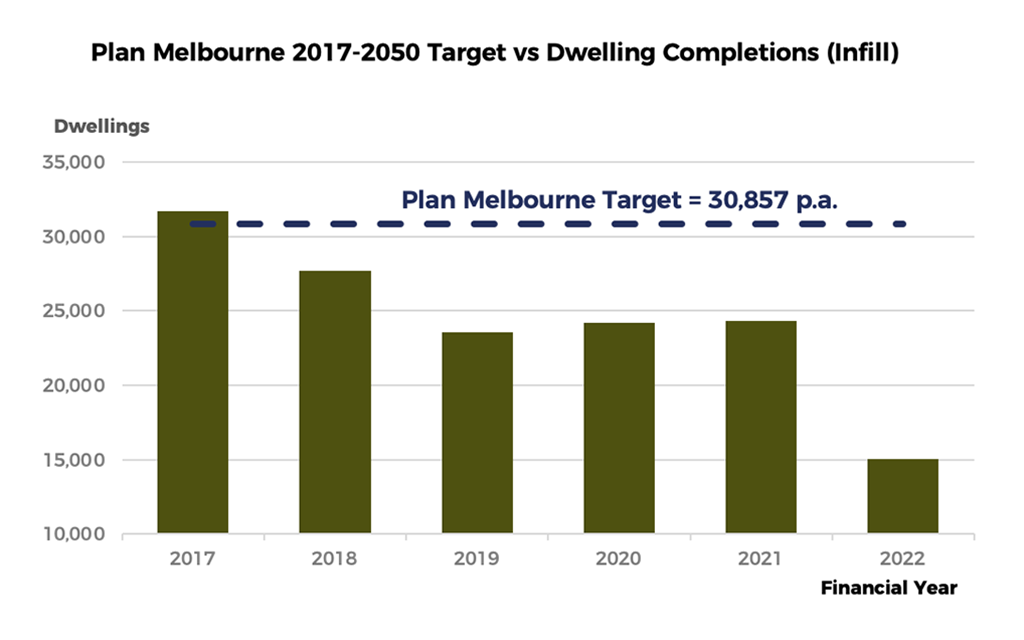
When it comes to setting housing targets, rather than threatening local government with the removal of its powers, State premiers would perhaps be better served by ensuring the targets they set are achievable.
Designed to tackle a spectrum of housing-related issues, including rapid population growth, diminishing supply, and worsening affordability, housing targets have become the ‘go-to’ policy response for governments seeking to accelerate supply and stabilise prices, typically within a specified timeframe.
Mirroring the initiatives of their counterparts in the UK, USA, NZ, and Canada, governments across Australia, have enthusiastically embraced housing targets as a step to addressing their worsening housing woes.
In recent months, the National Cabinet set a target of 1.2 million “well-located” homes to be delivered over five years, beginning in July 2024. Meanwhile, the Victorian & and NSW state governments have each set ambitious targets of delivering 80,000 and 75,000 dwellings respectively, per annum. Neither state has previously come close to achieving this figure.
Introducing Accountability
Setting housing targets is a positive step, if for no other reason than it brings an acute focus to the magnitude of the task facing our cities and regions.
Furthermore, targets provide a widespread understanding of the dynamic demand and supply factors impacting the housing market. Whether it be declining home ownership, infrastructure shortfalls, or immigration, greater transparency of an issue high in national significance should be welcomed.
Perhaps most importantly, housing targets bestow an explicit measure of accountability upon our elected officialdom, who, naively or otherwise, have enthusiastically embraced targets as part of the solution to a crisis that continues to worsen on their watch.
At What Cost?
Determining a prescribed number and type of dwellings over a designated timeframe first requires a detailed analysis of a multitude of complex factors relating to new housing development at the local level.
Albeit sound in concept, evidence from other jurisdictions where housing targets have been adopted, reveals that without undertaking detailed analysis to establish practical and realistic development potential, they are destined to fail. Furthermore, once set, housing targets can be difficult to adjust if, and when circumstances change.
Housing targets lacking a sufficiently robust basis are likely to generate a series of unintended consequences. This includes the overdevelopment of certain areas, without adequate consideration of accompanying infrastructure such as public transportation, schools, healthcare facilities, and parks. They can also inadvertently foster a short-term focus on quantity over long-term quality.
Development capacity, land use zoning, project feasibility, environmental factors, economic forces, and housing preference all impact the ability of new development be delivered. Each of these, together with a variety of other factors, need to be understood in advance of the policy development process and well in advance of the inevitable political hyperbole declaring that a solution to the housing crisis has been found.
The UK Government’s recent decision to abandon its annual target for 300,000 new homes, having never met the long-held ambition, should be instructive for local policymakers. This should include an understanding of the reasons why the target in the UK is now “advisory”, and why councils are allowed to build fewer homes if they can show hitting it would significantly change the character of an area.
Moving Beyond Visions of the Ideal City
Our cities and regions are not unblemished geographic canvasses presenting a boundless opportunity to deliver a vision of the city based on an idealistic aspiration to construct a better future.
Caught between the crossfire of contentious battles over individual development proposals and the creation of perennially unfulfilled visions, the role of planning in addressing the national housing crisis has perhaps never been more important.
While the entire, existing metropolis (and beyond) must do its part, simply assuming that it is the role of the ‘Missing Middle’ to pick up the slack, is both lazy and ill-informed.
Contrary to the manner in which it is viewed by the planning world, the ‘Missing Middle’ is not a single geographic unit presenting a wholesale opportunity for redevelopment that can be planned in a ‘top-down’ fashion. As evidenced across metropolitan Melbourne over the last decade, the rate, type, and volume of development that has occurred across the so-called ‘Missing Middle’ has varied greatly.
Some suburbs such as Brunswick and Box Hill have supported substantial apartment development, while many haven’t. Some suburbs, such as Kew and Hawthorn, have seen vast swathes of their detached dwelling stock demolished. Some suburbs such as Dandenong and Frankston, have experienced very little high-density development despite two decades of structure planning and government investment. There are good reasons for all of this, but these suburbs are not the same, despite all being located within the ‘Missing Middle.’
There is perhaps no better example that governments can no longer afford to impose ill-conceived, top-down metropolitan-wide directives than the discrepancy that exists between the targets set out in Plan Melbourne 2017-2050, and actual development outcomes.
Aiming to deliver 70%, or almost 31,000 new dwellings in Melbourne’s established areas annually, this target has fallen well short in five of the last six years. In 2022, the number of new dwellings delivered in established areas was less than half of the target outlined in Plan Melbourne.

SOURCE – ABS Dwelling Completions, Quantify Strategic Insights
Lessons to be Learnt
The importance of planning in the face of a growing housing crisis cannot be overstated, at least in theory. Housing supply across Australia has remained largely unresponsive to the increasing demand, leading to rising prices without a corresponding increase in housing availability.
Addressing the ongoing housing shortfall and determining where, how much, and what kind of development can realistically be achieved should be the cornerstone of government housing policy.
To improve the effectiveness of housing targets and address the persisting shortage, it is imperative to adopt a more refined and rigorous approach that analyses the specific attributes of local areas, so that a realistic and practical understanding of the volume and type of planned growth, is understood. Establishing a robust reporting system for forecasting, planning, and monitoring new housing development is essential. Without such an approach, housing targets are at a considerable risk of failure.
When evaluating the current limitations imposed by the planning system, including Plan Melbourne, it is instructive to draw lessons from the UK's Barker Review, undertaken almost two decades ago.
The Barker Review provided valuable recommendations to enhance the functioning of the planning system. Central to these recommendations was the core objective of incorporating market information into the planning process, making better use of data related to prices and preferences. This included the preparation of Strategic Housing Market Assessments (SHMAs) which aimed to introduce a more evidence-based approach to policymaking, ensuring that housing supply aligns closely with the actual needs of the population.
Now recognised as a vital tool for planning housing, SHMAs aid in informed decision-making and fostering a more strategic, evidence-based approach. Continuous efforts to refine the SHMA process contribute to its ongoing evolution and effectiveness.
A Better Way
The intricate and ever-evolving nature of housing markets poses a formidable challenge when attempting to accurately project future housing demands, and in turn, set housing targets. The changing composition of urban populations and evolving development practices demand more sophisticated analysis, underpinned by a nuanced, evidence-based critique if housing targets are to stand a chance.
The conventional practices and underlying assumptions in setting housing targets have long proven to be inadequate. This underscores the need for a strategic planning approach, significantly more rigorous than what is currently practiced in many jurisdictions. This would enable better policy formulation, and a system to ensure that the established targets can be met, allowing for adjustments when necessary.
In navigating the complex landscape of housing markets, adapting to the evolving urban dynamics, and overcoming the limitations of conventional practices, a strategic and nuanced planning approach emerges as the key to not only setting realistic housing targets but ensuring their successful realisation through adaptability and continuous refinement.
Rob Burgess is a town planner with over 25 years of experience, having worked in both the public and private sectors. Applying evidence-based insights, Rob's expertise lies at the intersection of population dynamics, town planning, and property markets. He is regularly engaged to undertake market research, provide strategic advice to clients, and sharing his thoughts on current and future trends. Rob is a Principal with Quantify Strategic Insights.
Photo: Jorge Láscar via Flickr under CC 2.0 License.













The Role of Planning
"...the role of planning in addressing the national housing crisis has perhaps never been more important."
I'm sorry but I believe planners are largely responsible for the housing mess. Just as in Soviet Russia and Communist China the top sets a plan. The middle sets larger plans to impress the top, and the bottom lies about progress. To correct the shortfall, the planners need more funding, and around we go again.
We live in a Montana USA county with population ~120,000. Our Growth Plan is 158 pages. Our Trails Plan is 90 pages. All prepared with the help of consultants. Very few residents read them but the plans must conform to Federal and State law, Zoning and other Regulations. County commissioners fear lawsuits. The Planning Commission have their own agenda so the entire planning and approval process can take months and years. The result is a crisis of affordable housing.